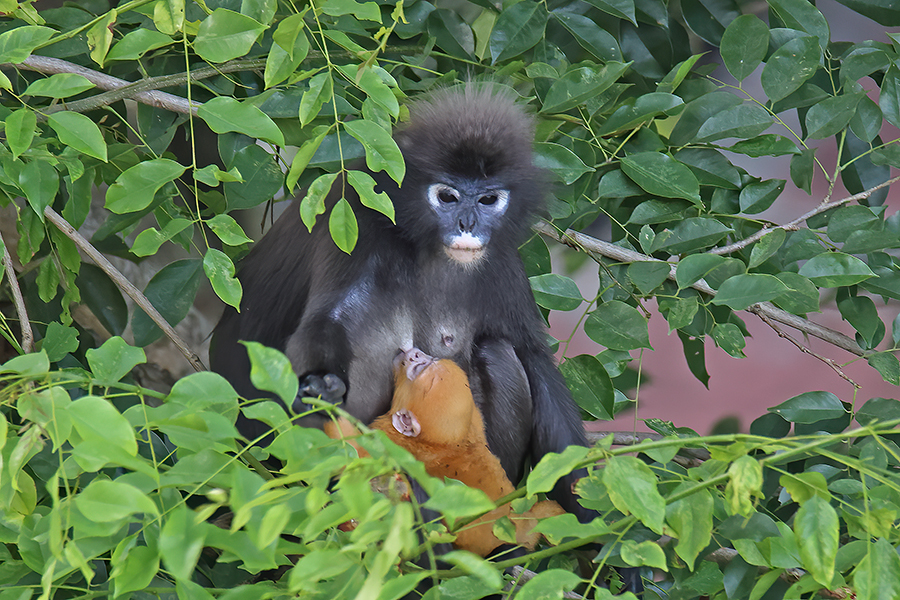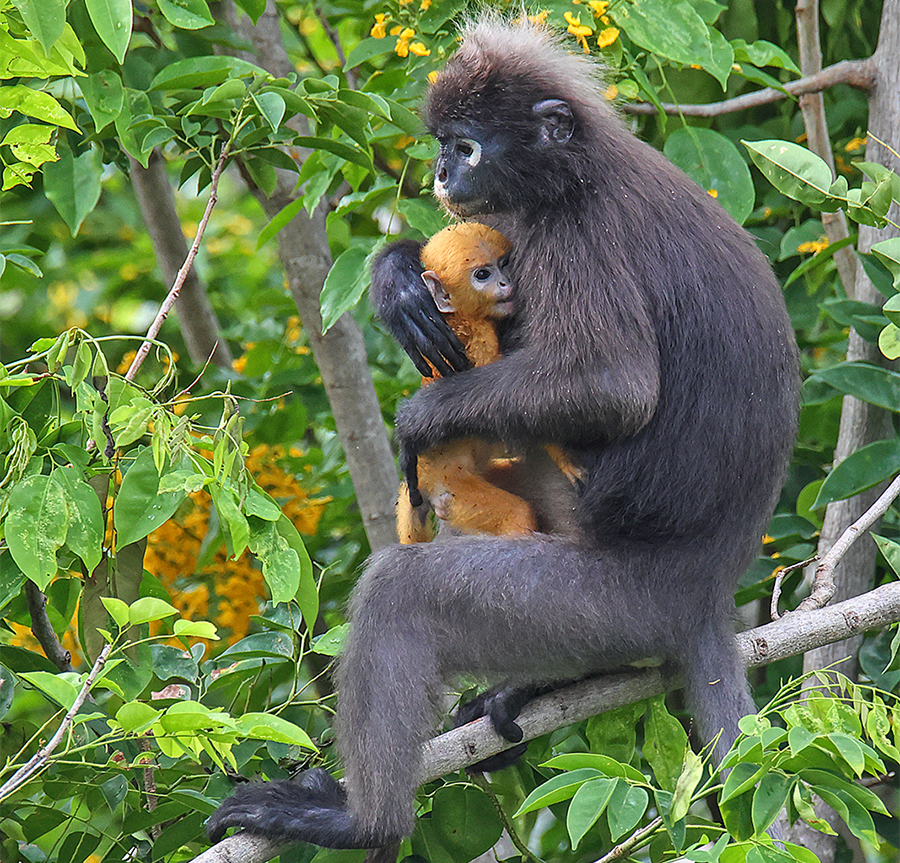REPRODUCTION
Both male and female Dusky Langurs are sexually mature between 3 to 4 years of age. Females have a menstrual cycle lasting approximately three weeks. Oestrus is often accompanied by a swelling of the genitalia. Breeding can occur throughout the year, however most births occur between January and March. The gestation period is 145 days and the interval between births is around 2 years. For the first weeks the infant langur is breast-fed every 90 minutes by its mother. She has assistance from other females in the first weeks to do other chores. Newborn Dusky Langurs have bright orange fur with pink skin. The orange fur begins to she the second week after birth. At around three weeks, black-greyish hair starts to appear on the forehead, tail and limbs. By the forth month the head and back are black-grey with only the cheeks showing traces of orange. After six months the entire body is light black-grey which grows darker with age. The second layer of white fluffy hair starts growing after six months.
It is not known the age at which an infant Dusky Langur is considered weaned.
I first saw orange babies in the adjacent forest in late April 2020. A mobile creche was seen to be moving through the forest and females carrying the babies met up later. It was clear the mother(s) had assistance from other females in the troop. I speculated the babies were twins and I only saw one infant with the troop in subsequent days. Twins have been recorded being raised successfully but this is usually not the case. In hilly terrain, with many tall trees to negotiate, the female is not able to carry two infants.
 |
Assisting the mother by taking the infant for a time
|
 |
Attending to toilet matters
|
There are several theories put forward as to why some langur species have orange babies. One of these is that the infants are easier to see in the forest for their carers. There are at least four species of Langur all belonging to the genus Trachypithecus that have orange babies. They are; Dusky Langurs, Silvery Langurs, Phayre's Langurs and Francois Langurs. The first two are mainly found in peninsular Malaysia while the last mentioned is found in small pockets in Northern Vietnam and Southern China. The Phayre's Langur is found in parts of Southeast Asia from Thailand to India. It has most similarity to the Dusky Langurs and is classified in the same group. There are 18 recognised species in the genus Trachypithecus....which when translated from Greek means 'rough monkey'. The members of the genus are often referred to as Lutungs (Lutongs) which means 'blackness' in the Sundanese language.
 |
Silvery Langurs
|
 |
Francois Langur infant
|
 |
Phayre's Langur and infant
|
There is a small forest remnant on mainland Penang state where Dusky and Silvery Langurs interbreed. The offspring have diluted characteristics of each parent.
 |
The hybrid Langur is on the left
|
Corey L Booth wrote a review paper several years ago examining ontogenetic colour changes (these are irreversible changes in colour during the progressive development of a species) in a number of species. Booth concluded that the orange colour in langur species 'may illicit attention, protection and caregiving by adults'. The caregiving is at a critical point in the baby's life. I believe Booth to be correct but is there a biochemical trigger elicited in others by the appearance of the bright orange infant?
The orange colour would have arisen some time ago by a mutation that was favourable to survival. Natural selection would favour this brief colour change. The extra attention accorded the new arrival would have given a survival advantage.
Below are two images, of different infants, highlighting the attention that newborn babies get from other females in the troop. Other females will carry the baby to allow the young mother some respite from the constant burden. I have even seen 4 langurs with a baby confer when faced with a wide jump. The baby was passed to one of the group who must has been rated the best long jumper. The extra attention drops off as the infant changes colour.
 |
The mother is in the foreground and while she feeds the other two share minding duties
|
Even with the help of others the mother must keep up with the troop and jumps and feeds normally with the infant holding on tightly. It boils down to the fact that the infant's life depends on the integrity of its grip on the mothers belly fur. This is crucial even hours after the birth.
Below are several situations illustrated where the infant has to have a good grip on life. When plummeting from a high tree the mother will angle her body to take the impact of the branches but mostly during the jump both of her arms are readied for impact.
 |
Mother launches off the tall Sterculia tree. She will land in the foliage below right
|
 |
One arm is supporting at the beginning of the jump.......
|
 |
........but both arms are needed for landing
|
As mentioned, breast feeding is an important source of nutrients for the growing infant whose metabolic system will take some time to get used to a vegetarian diet. As the infant gets older the mother will give it some pre-chewed plant material with maternal associated enzymes.
The female Dusky Langurs invest a lot of time and energy in keeping their infant secure and well fed. The strong affection between the pair is obvious and a delight to witness (illustrated below).
 |
The breast-fed infant seems to think eating leaves is somewhat humorous.
|
In the period of observation of the troop in the adjacent forest there have been three babies born. With the last one I have been able to follow the colour change that happens in this species. These are shown in the subsequent pictures.
 |
5 days old
|
 |
9 days old
|
 |
23 days old
|
 |
33 days old
|
 |
43 days old
|
 |
55 days old
|
 |
58 days old (That is his Dad, the alpha male, whose head he is sitting on).
|
 |
70 days old
|
 |
78 days old
|
 |
87 days old
|
 |
93 days old
|
 |
95 days old
|
I was astounded to see the juvenile present itself on a high branch with the mother in sight. I was more surprised when he/she did a perfect dive to trees 30 feet below. I did note that Mum conducted the next dive, however.
 |
97 days old
|
 |
107 days old
|
 |
120 days old..no orange anymore
|
LIVING NEXT TO THE WORST PREDATOR
My location is in the Diamond Villa apartments in Tanjung Bungah on Penang Island in North Eastern Malaysia. There are several national parks on Penang Island and where we are near the shores of the Strait of Malacca we are essentially surrounded by trees albeit thin in places. The langur troop, which numbers around 20-25 forage in the trees around the periphery of the apartment buildings. Some weeks you will not see them for several days when they are up the hill at the back but they will eventually do their circuit. They have designated sleeping trees and a tall tree between the swimming pool and the road is used at least once a week. I look out for the Mums and babies to track their progress and I see the alpha male interacting with his harem at times. They are a non-aggressive species and will tolerate the reasonably close presence of man. I have seen them sitting on the fence and shifting momentarily into nearby trees when joggers pass.
 |
The forest running down the west side of the apartment block.
|
 |
| The trees at the end of the swimming pool form the northern boundary of the langur's domain. |
Most of the time the langur troop are foraging in the forest but they sometimes sit on the fence and roadside light fixtures or cavort on the top of the water tank. They seem to like using the ladder on the side of the tank and leap from there into adjacent bushes often displaying excellent parkour techniques by leaping at the concrete wall, running along it briefly and then launching themselves into the bushes. Langurs will also lick the exposed parts of the concrete to obtain minerals.
 |
| Expert at wall-running or parkour. |
 |
| Licking the exposed concrete |
The only other man-made objects the langurs come in contact with are the mirrors at corners in the internal road, the footpath lights and the fence, which is like a primate rapid rail system when they want to get somewhere in a hurry.
Elsewhere the power or telephone wires provide a convenient over-bridge.
There is generally a peaceful coexistence between human and langurs in the estate but the greater problem is summed up in the following image.........
......................high-rise apartment buildings have encroached on the langur's natural habitat.
BY FAR THE WORST PREDATOR OF ENDANGERED SPECIES, SUCH AS THE DUSKY LANGUR, IS MAN.
It must be remembered that 90% of the Dusky Langurs live in Malaysia.....it is a Malaysian primate and it should be carefully managed in the places it lives.
.
WHAT IS BEING DONE?
Malaysia generally has a poor record for conservation and nurturing native species. Regulation is in place to protect a number of species but there is poor policing of the law. Often it is on the shoulders of dedicated individuals to do something positive. I have met a number of them. So it is the case with Dusky Langurs, at least in Penang state where the white knight (or more correctly ...lady) is a young local currently doing her PhD on the distribution and habits of Dusky Langurs. Jo Leen Yap has driven the establishment of the Langur Project Penang (LPP), whereby she takes the plight of this primate to the public, especially the very young children. It is educating them that will show results and a change of mindset for the future. As well as her fieldwork, Jo Leen gives talks, shares video-links and is involved in many public discussions. The conservation field needs 50 Jo Leen Yaps. She has raised money for an overbridge so that langurs crossing roads to other food trees don't run the risk of being hit by cars and trucks. Why I don't think this initiative does anything of significance to solve the problem of the halving of Dusky Langur numbers in Malaysia in the last 30 years, it does provide ....PUBLICITY.
The other problem that Jo Leen has addressed is the illegal trade in this species. The babies are too cute for their own good and misguided members of the public think they will be better mothers than the infants own mother. So it is baby clothes and fast-food for you little orange one. I would let any young human female have the babies to show off to their friends if they are prepared to breast-feed them every 90 minutes for a year. In truth the babies will die a horrible death under such misguided human husbandry. It is illegal to have them as pets but again enforcement is lacking. Whenever Jo Leen becomes aware of these illegal pets she will alert the authorities.
Her work is best summed up by the Habitat foundation, as follows:
MALAYSIA; PRESERVE YOUR DUSKY LANGURS
This is not a good report card






























































Comments
Post a Comment